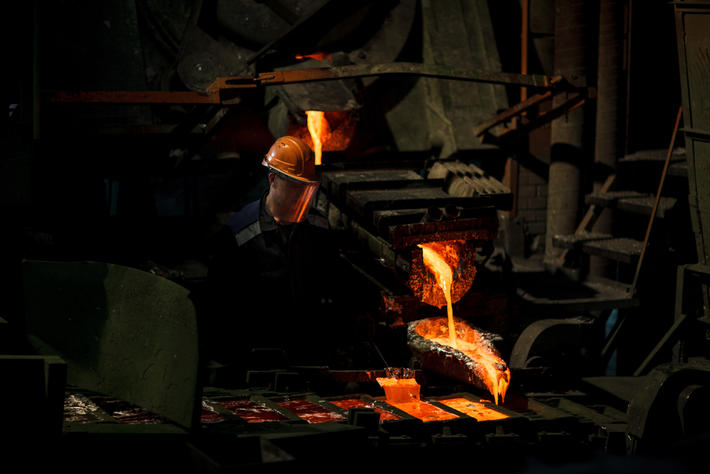
Performance of the foundry sector in 2023: the year starts well, production and turnover grow in the first quarter
In the first quarter of 2023, the foundry sector recorded positive performances both in terms of production and turnover. Entrepreneurs' expectations for the coming months, however, indicate a contraction in demand.
Growth in the first quarter of 2023 of Italian foundries: production and turnover increase
In the first three months of the year, the cyclical change in production (in tonnes) stood at +7.1% compared to the fourth quarter of 2022. The first quarter of 2023 also started well in relation to the results of the same period of 2022: the trend change in net production shipped grew by +3.3%.
45% of responding companies indicated an increase in production levels; for 28.3% of cases production remained stable compared to the previous quarter, while in 26.7% of cases it decreased.
Even from the point of view of turnover we are witnessing similar dynamics, with an economic growth of +5.8% compared to the previous quarter, which reaches +7.7% if we compare the revenues of the January-March period with those of the same period quarter of last year: a figure that is easily explained by observing how at the beginning of 2022 the strong inflationary push, which characterized the rest of the year, was only in its initial stages.
The turnover of Italian foundries is growing on a quarterly basis for the absolute majority of companies that responded to the survey (51.7%), while the remaining part of the companies interviewed is divided between those who indicated a stable turnover compared to the previous quarter (20 %) and those who, however, reported a setback (28.3%).
Italian foundry performance 2023: production costs
If we observe the data relating to production costs, a decidedly mixed picture can be seen in the first quarter of 2023 of the Italian foundry market.
Faced with the decrease in costs relating to electricity, with the Pun (Single National Price) falling by -35.5% compared to the previous quarter, the trend of raw materials and other main variables is more multifaceted.
Ferrous raw materials see an average drop in the prices of cast iron in blocks (-11.3% on the previous quarter), however compensated by the growth in scrap prices, both of packs of 30X30 foundry sheet metal (+4.3%) and of loose sheet steel (cat.50), at +10.6%. On the non-ferrous metals front, however, if secondary aluminum is substantially unchanged (-0.6%), zinc instead grew by +4.3% on the previous quarter.
As regards the costs of auxiliary materials and subcontracting, a growing trend is confirmed, on the long wave of the high energy costs of 2022.
The drop in energy costs, which however remain at levels much higher than those of the years immediately preceding the crisis, does not therefore correspond to a similar decrease in the other main production costs.
Order visibility and performance of the foundry sector in 2023
In the latest monthly survey, short-term expectations fall below the sufficiency threshold: the SIX index (which summarizes the responses on companies' prospects for the six months following the survey) is in fact compressed to 47.3 points, given lower than 50 points which represent the transition threshold between positive and negative sentiment, and is confirmed to be decreasing compared to the result of previous months.
If we analyze the responses of the individual sectors, we note a rather different trend between ferrous and non-ferrous metal foundries. The responses of the former outline a not particularly positive picture, with index values below 50 points for both steel and cast iron foundries. Non-ferrous metal foundries, however, are more optimistic: for this sector the SIX index reaches 67.9 points.
Finally, from the point of view of order visibility, in the first quarter of 2023 this stands at 2.6 months. The data is rather homogeneous between the different sectors, even if steel foundries present a value slightly higher than the average (2.8 months), while cast iron foundries show the lowest value (2.5 months).
The comment: first quarter 2023 comforting for the foundry market, but today we see a slowdown
«2023 – underlines the president of Assofond Fabio Zanardi – has opened for the sector with a positive result in terms of production and turnover. From the point of view of short-term prospects, the investigations of our Research Center reveal an initial slowdown in orders, which weighs on the sentiment of members. Since there is, at least for the moment, no prospects of recession by 2023, the decline in current demand is probably attributable to the disposal of stocks along the supply chain, with the hope of finding stronger demand starting from autumn 2023. The current scenario, in any case, it is confirmed to be highly volatile, with all the risks connected to it, as demonstrated by the performance of raw materials, auxiliary materials and subcontractors which are still in the midst of the inflationary trend that we experienced in 2022. On the other hand, there is a "normalisation" of energy costs, it is true, but at levels that are still very high compared to those before the crisis and with the exceptional measures launched by the government last year which are running out. There therefore remain strong unknowns linked to the structural competitiveness of Italian and European foundries in the global context, and the stability of the European economy with inflation and rates at current levels.»
Source: In Fonderia – ll magazine dell’industria fusoria italiana


